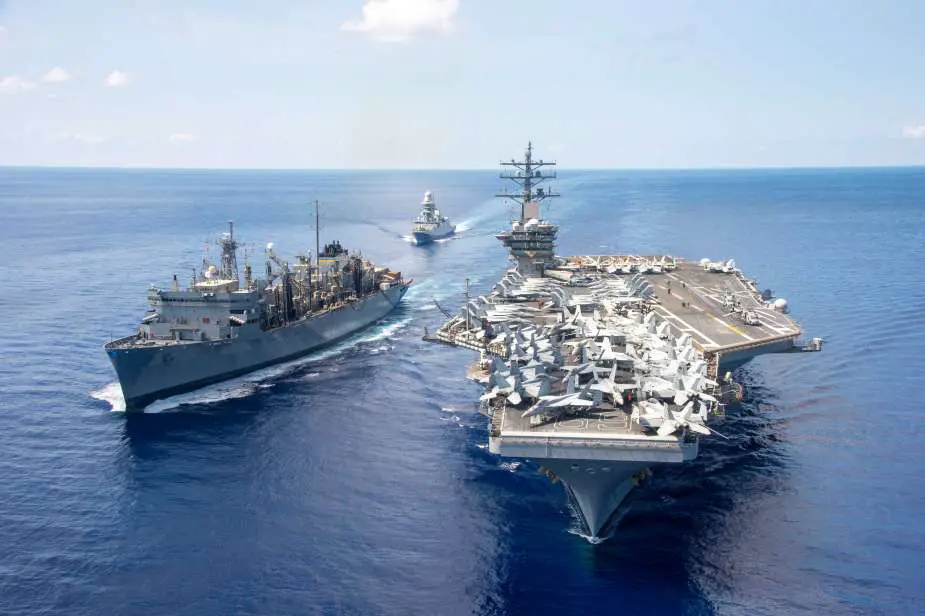Breaking news
Second US aircraft carrier USS Dwight D. Eisenhower ready to sail to Israel.
According to the Wall Street Journal, the U.S. Navy's aircraft carrier USS Dwight D. Eisenhower is set to deploy to Israel, initially crossing the Atlantic into the Mediterranean. This move follows an announcement by Pentagon Press Secretary John Kirby on October 11, 2023, during a press conference, stating that the Eisenhower and its strike group would be "available if needed" in the region. The deployment is particularly noteworthy given the ongoing conflict between Israel and Hamas, as well as the presence of another U.S. aircraft carrier, the USS Gerald R. Ford, already in the Mediterranean.
Follow Navy Recognition on Google News at this link
 Nimitz-class aircraft carrier USS Dwight D. Eisenhower (Picture source: US Navy )
Nimitz-class aircraft carrier USS Dwight D. Eisenhower (Picture source: US Navy )
The Eisenhower's deployment has been long-planned and is not a direct response to the current conflict in the Middle East. However, its presence will undoubtedly "strengthen relationships with our allies and partners," according to Rear Admiral Marc Miguez, commander of the strike group. U.S. Defense Secretary Lloyd Austin has also ordered the USS Gerald R. Ford to be ready to assist Israel, emphasizing the strategic importance of having two carrier strike groups in the region.
With a crew of over 5,000 sailors, the aircraft carrier is supported by the Norfolk-based cruiser USS Philippine Sea and the destroyer USS Gravely. Additionally, the strike group will include various fighter-bomber squadrons from Virginia Beach known as Gunslingers, Fighting Swordsmen, Rampagers, and Wildcats. The Eisenhower recently underwent a 15-month maintenance period from August 2021 to December 2022, ensuring it is in optimal condition for this deployment.
The USS Dwight D. Eisenhower belongs to the Nimitz class of aircraft carriers. With a displacement of 101,600 long tons and an overall length of 1,092 feet, its waterline width is 134 feet, while its total height reaches 244 feet. What truly sets the Eisenhower apart are its advanced propulsion systems. The ship is powered by two Westinghouse A4W nuclear reactors, allowing it to reach speeds exceeding 30 knots. These reactors also provide the energy needed to power its four steam turbines and four shafts, delivering a total power output of 260,000 hp. Thanks to this setup, the Eisenhower can operate over unlimited distances for a period of 20 to 25 years without needing fuel resupply.
In terms of operational capabilities, the Eisenhower is equipped with a range of detection and electronic warfare systems. It has 3D AN/SPS-48E and 2D AN/SPS-49(V)5 air search radars, as well as AN/SPQ-9B target acquisition radars. For air traffic management, it is equipped with several control radars, including AN/SPN-46 and AN/SPN-43C. In terms of armament, the ship is well-equipped with two RIM-7 Sea Sparrow missile launchers, two RIM-116 Rolling Airframe missile launchers, and several 20 mm Phalanx CIWS cannons for close-in defense. The ship's air complement is also impressive, with the capacity to carry up to 90 fixed-wing aircraft and helicopters.
The deployment of a second aircraft carrier in the Mediterranean could serve as a strong signal of deterrence against any hostile actors in the region. It remains to be seen whether the Eisenhower will relieve the Ford or if both carriers will operate simultaneously in the region. Either way, the United States maintains ready forces to reinforce its deterrence posture, as stated by Defense Secretary Austin.
Although its primary mission is not directly related to the ongoing conflict between Israel and Hamas, the presence of this new aircraft carrier offers strategic options for the United States and its allies in an increasingly unstable region.





























